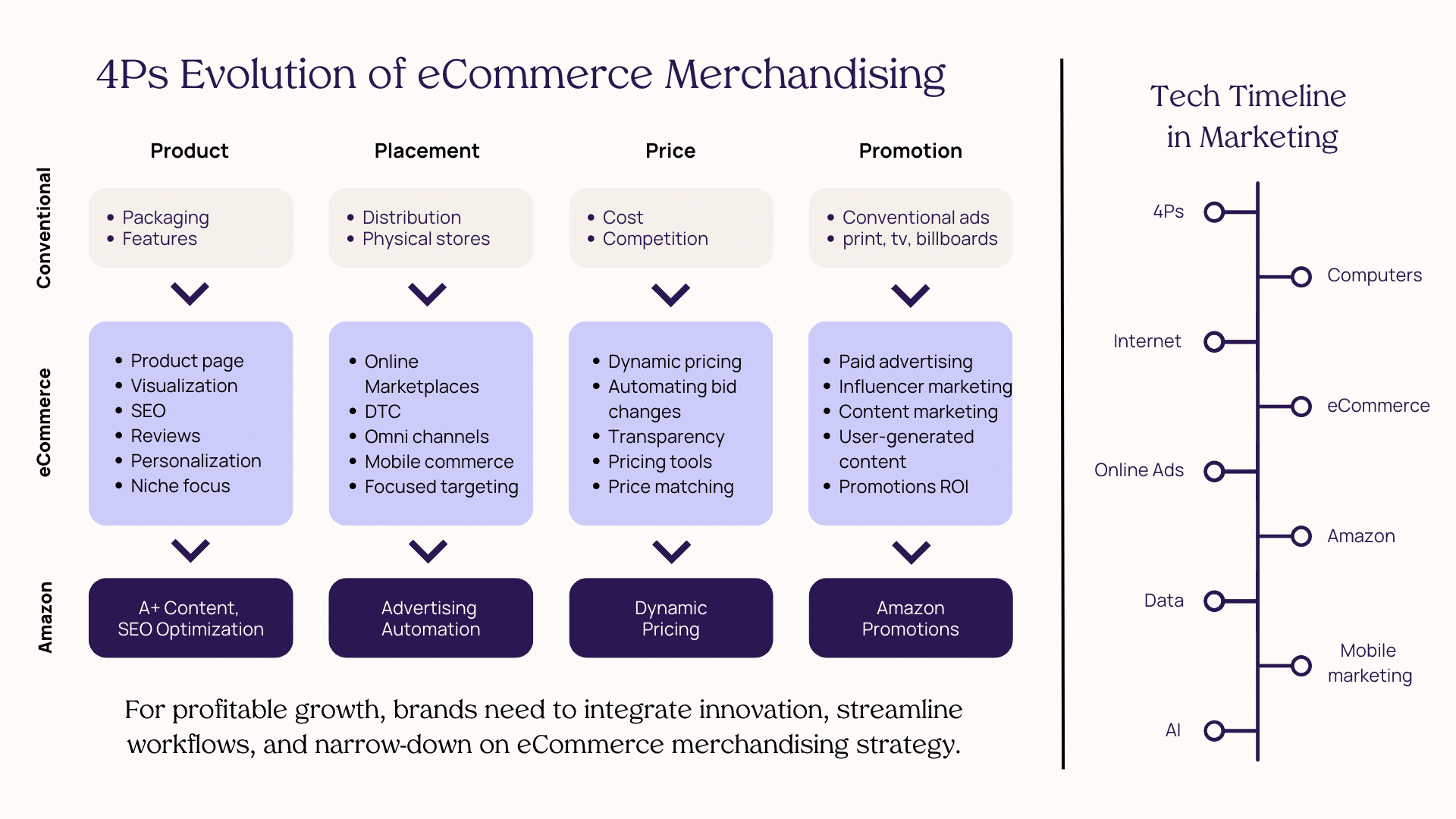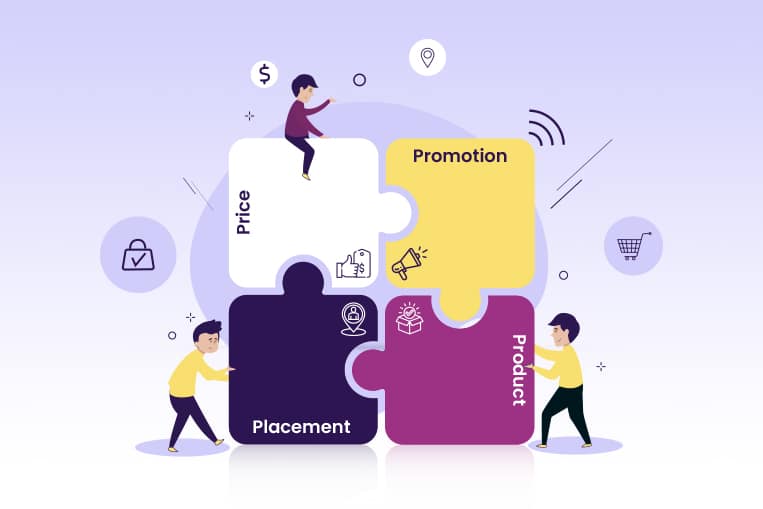If you have a formal education in business or marketing, you probably have heard about the 4Ps of Marketing — Product, Price, Placement, & Promotions. While it may seem outdated today, there is more to it than meets the eye.
The 4Ps of marketing represent the key components of selling products or services. This decades-old framework is a simple and effective structure to develop a marketing strategy. Despite the rapid tech evolution in marketing, the 4Ps can still be used in eCommerce merchandising to grow businesses profitably.
In this blog, we dive into why the 4Ps are still relevant today, how they evolved with eCommerce growth, and how to win at eCommerce merchandising through the 4Ps.
What are the 4Ps of Marketing?
The 4Ps are often called the ‘Marketing Mix.’ They are a set of tools marketers use to make customers buy a product or service. The concept of the 4Ps is rooted in the article ‘The Management of Marketing Costs’, published in the Harvard Business Review (1948). The author, James Culliton called marketing executives “artists” or “mixers of ingredients”.
Later in the 1950s, Harvard Professor Neil Borden described these marketing executives as:
‘The one who is constantly engaged in fashioning creatively a mix of marketing procedures and policies in his efforts to produce a profitable enterprise.’
In 1960, E. Jerome McCarthy formally conceptualized the 4Ps of marketing in Basic Marketing, A Managerial Approach. Since then, this simple yet powerful framework is still taught in business schools. Why? Because marketers still need to ask the following questions.
- Product: What is unique about your product or service?
- Price: How much do you charge for your product to maximize sales or profit?
- Place: Where do you advertise your product so your customers can find you?
- Promotion: How do you promote your product and reach your audience?
From a top-down approach, these four Ps fundamentally question everything a business needs to create a marketing plan. The reason the 4Ps have stood the test of time is because they adapt to technology, and trends, and are easy to implement. For example,
- Product: Your manufacturer offers recyclable packaging options at extra cost. Would you choose it?
- Price: A competitor launched a cheap electric toothbrush. How do you price your products?
- Placement: A social media channel was launched sharing Amazon products. How do you place your ads?
- Promotion: Walmart launches one-hour expiration coupons. How do you incorporate it into your strategy?
What’s the role of tech in marketing?
Since the 1960s, business technology has come a long way. Every advancement has brought new opportunities for marketers but also made it more challenging. Here is a timeline of some innovations since the 4Ps were introduced.
- Computers: Since the 1970s, computers have allowed marketers to work with spreadsheets more efficiently.
- Internet: The internet emerged in the 90s and completely changed how businesses communicated.
- Search Engines: Shoppers started to find products through search queries, which gave marketers an additional advertising channel.
- Social Media: Social media adoption in the 21st century has allowed brands to tell their stories and engage directly with shoppers.
- Consumer Data: ECommerce growth gave more data to brands, which they use to gain consumer insights to target efficiently.
- Mobile Marketing: Smartphone adoption boosted eCommerce as more shoppers shopped online.
- AI & Automation: Artificial intelligence enables sellers to analyze complex data more efficiently.
The above-mentioned innovations all make up our current marketing ecosystem giving marketers more challenges but also more opportunities. For instance, we can create an eCommerce store in less than 30 minutes, advertise products anywhere in the world within a few hours, and target a specific audience who like sushi. Opportunities are augmented by access to thousands of data points within seconds.
Due to this disruption in merchandising, the ‘artists’ were spoiled for choice. While some early adopters of technology grew their businesses fast, many eCommerce merchandisers lost focus and ROI on their eCommerce business.

How has tech evolved the 4Ps?
With several opportunities at their disposal, brands need a framework to analyze where they lost focus. The 4Ps can help brands understand their marketing strategy better as it is adaptable and easy to implement.
To bring the focus back, we need to understand how technology impacts the marketing mix. Expanding on them can bring us back to what is the most important part of each P.
Let’s dive into how each evolved.
Product
Products living on shelves have been replaced by digital listings. This shift may have changed marketers’ approach to displaying products but the fundamentals of selling have stayed the same.
Imagine walking into the food aisle and looking at the canned soups on the shelf — you find various brands with different flavors. Now imagine searching for ‘canned soup’ on Amazon, and scrolling through the first page. The core difference is that at the store there is only packaging to look at, whereas, on Amazon, you have a whole page of content.
Content: Today, brands have more content space. Product pages have more words to sell, images from various angles, videos, and social proof. They can also provide a 360 view of the product. With more space to provide content, the bar has risen. Customers expect more information to decide about a product which pushes marketers to be more creative and stand out.
Reviews: Shoppers always need social proof. Before, word-of-mouth endorsements from a neighbor or family member worked. Now, shoppers rely on internet ratings and reviews. More positive reviews increase your selling chances. Historically, you wouldn’t have other shoppers roaming around the product providing unsolicited feedback in the shopping aisles. Customers now lean on reviews on Amazon, Walmart, or Google which shows merchandising is more meritocratic. If the product is worth it, it will succeed.
SEO: Getting search traffic is the cheapest way of getting traffic to your products. Showing up in a search query on Google and marketplaces like Amazon and Walmart means valuable low-cost sales. Having an SEO-optimized product listing increases your visibility but it is highly competitive to rank on the first page. SEO has provided a way for smaller brands to enter the market as they find holes in what consumers want and need.
Niche: Today, brands focus more on niche products. This way they can become the best sellers of that specific type of product. For instance, brands can build an entire business around selling iPhone covers. With this focus, they dominate their subcategory and can leverage their position to grow sales. Before, selling niche products was expensive due to limited reach and low sales volume. Today, it is easy and cheap to sell online, hence brands are more specific.
Takeaway: Standing out through product content is more challenging than it used to be. But if you do it effectively, you can steal market share away from those not putting the effort in and other established brands.
Placement
Digital marketing has opened up many online distribution channels. Brands can now display their products anywhere in the world, to any audience. With infinite options, placement strategies need to be more targeted.
Before eCommerce, merchandisers did not have the luxury of distributing products through targeted channels. In the past, small brands were only able to distribute locally, more established brands could distribute nationally, and enterprises could expand internationally. Placement was predetermined, as your business’ size was was largely dedicated to to the choices you had.
Now you can list your products anywhere. A small brand can compete with a big brand. Low-cost headphones can be found on the same digital shelf as Bose headphones. It allows smaller players to compete with larger players if they get their product content right.
Here are some popular placement channels and trends today:
Online Marketplaces: Now anyone can compete on the biggest online marketplaces like Amazon. Brands can get their products in front of millions of customers with small investment and grow faster than ever. This is one of the biggest shifts in eCommerce. Back then, smaller players had no such opportunities.
Direct-to-Consumer (DTC): Before, DTC was a luxury reserved for established brands with physical stores. As eCommerce website development has become quick, easy, and cheap, any seller can create their online store and become an online seller. In combination with today’s marketing channels and streamlined operations through software, small stores compete with established names.
Mobile Commerce: Mobile responsive websites are easier to use for shoppers providing a better experience. Shopify says nearly 42% of eCommerce sales will come from mobile by 2024. Such a trend could not have been anticipated decades ago. Those prepared to take on this trend will increase their presence and take market share away from their competitors.
Focused-Targeting: Placement is also about reaching the right audience at the right time. When advertisers largely used billboards, events, and TV commercials to reach audiences, they could only target a broad audience which was expensive. Today marketers don’t need to target everyone. Digital ads can be more targeted and efficient.
Key takeaway: Placement is about understanding your audience and targeting them efficiently. Marketers must test the most effective channels through AI and automation to streamline the process and maximize ROI.
Pricing
Pricing has become more competitive than ever before due to more sellers joining eCommerce. With minimal start-up costs and low barriers to entry, technology provides everyone with the right merchandising tools. To stay on top, brands need better pricing tools to stay profitable and competitive.
Businesses used to adopt different pricing strategies to find their place in the market. Today, we have all the consumer and competitor data to make more than an educated guess. Brands looking to activate that data can fill very profitable gaps in the market.
Today, pricing is more about taking data-driven decisions and adapting quickly, rather than pricing strategies in the marketing books.
Dynamic Pricing: Brands today use algorithms to find optimal pricing for their products. Based on various factors such as supply and demand, competitor pricing, and customer behavior, brands make data-driven pricing decisions. Algorithms learn what price changes will maximize profit or sales velocity.
Automation: Price changes in conventional ads were slow. Today, merchandising experts use pricing tools that automate price changes. Price changes can be automated for hundreds of products, which is impossible to do manually. Automation can save you time and money, and give you better results through real-time pricing changes.
Transparency: The internet has made it easier for customers to compare prices online. Price is a huge factor in purchasing decisions. A brand must offer the best price to avoid losing a sale. Today, even brick-and-mortar stores have price-matching policies. The biggest reason Amazon and Walmart have grown so much because they offer the best prices.
Key takeaway: Optimizing pricing requires continuous analysis of historical price performance. To achieve the right pricing for your sales or profit margin, marketers need dynamic pricing tools, particularly on competitive marketplaces like Amazon.
Promotion
Brands want the most ROI. While there are various ways to put your products in front of customers, the challenge is finding the most efficient ways.
With traditional advertising methods like print, radio, and television, results were inefficient and untrackable. Today, the Internet has augmented the previous methods and nearly all digital platforms can calculate ROI.
Paid advertising: Paid advertising has become a crucial element of product promotion. Brands can use digital ads to target specific audiences. While paid advertising is becoming highly competitive, brands need automation in their workflows. If a brand doesn’t leverage AI for data analysis, competitors will.
Influencer marketing: Celebrity endorsements have become influencer marketing. Social media has opened personal media channels for everyone, so anyone can create a following. In the past, endorsements required agencies, but now Direct Messages (DMs) on Instagram can put your product in millions of hands. While brands pay high amounts for social posts, only 4% trust their effectiveness.
Content marketing: Content is still king for many brands. Inbound content marketing helps brands write problem-solving articles seeking the right audience. Despite the tricky ROI of content marketing, brands invest in content to acquire traffic and improve conversion rates over the long term.
User-generated content: Customers now promote your product. If a customer had a poor experience with your product, they can share it online. You can find product reviews not only on product listings but also on social media and forums like Reddit. Sometimes promotion is not always controlled by brands. If a negative review becomes viral, it can significantly hurt your sales.
Key takeaway: Calculating the ROI on various promotions is key to boosting sales and creating a growth flywheel for your product. Using tools to forecast outcomes can help you make profitable decisions.
Tech solution for eCommerce merchandising
As tech-driven eCommerce grows, merchandising experts face challenges to focus on the winning strategy. With more choices, brands are not sure what gives them the highest ROI on all 4Ps.
It requires a lot of time and money to run thorough A/B testing. Even if those tests are done, the actionable insights have a shelf-life and may expire by the time you implement them. Today’s dynamic market requires real-time data analysis and action.
Tech needs to work with your marketing strategy. To manage these opportunities brands need to integrate the 4Ps into their strategy by using software like ours.
Streamlining the 4Ps on Amazon
Using one of the biggest marketplaces as a starting point, we can see how AI, and automation can simplify time-consuming workflows.
As the decades-old text stated, creative mixers are ‘constantly engaged in their ‘efforts to produce a profitable enterprise’. In the spirit of this, merchandisers need to adapt to technology and the latest trends to grow their brands.
For merchandisers to continue to adapt it’s imperative to revisit the fundamentals. That’s why we have augmented the 4Ps to represent the evolution of the 4Ps. Here is what it looks like when you zoom in on a product listing through this upgraded 4Ps lens.
 Product Content: Amazon content is crucial for organic growth and successful Amazon PPC campaigns. To streamline your content better, merchandising experts need to consider the best content practices native to their marketplaces. It helps with more clicks and conversions, increasing your BSR and decreasing your ACoS.
Product Content: Amazon content is crucial for organic growth and successful Amazon PPC campaigns. To streamline your content better, merchandising experts need to consider the best content practices native to their marketplaces. It helps with more clicks and conversions, increasing your BSR and decreasing your ACoS.
Ad Placement: When you zoom into Amazon through the 4Ps, you will see several ad placements on Amazon which revolve around three types of Amazon ads; sponsored product, sponsored brand, and sponsored display. To understand and test placement strategies, brands need advertising software that uses AI to optimize campaigns. AI optimizes through bidding on high-performing keywords at the best times. The more optimized a campaignis, the lower the ACoS. With a lower ACoS, brands can increase budgets, increasing sales and ROI.
Pricing: Due to competitive Amazon pricing, brands struggle to sell profitably. Lowering the price can increase sales velocity while leaving small profit margins. Increasing the price provides better profit margins, but decreases sales and hurts your BSR. Using dynamic pricing can help you find optimal pricing that will help you grow profitability.It can also automate price changes on thousands of products every day.
Promotions: Shoppers are attracted to Amazon’s deals, coupons, and exclusive promos. Running promotions can boost your sales, improve your BSR, and get reviews. However, promotions may not always give a positive ROI. But you can forecast the return on promotions even before starting a promotions campaign through the Trellis eCommerce merchandising platform.
First-ever eCommerce Merchandising Platform
With the evolution of eCommerce merchandising, brands with the most streamlined 4Ps will win. A big brand cannot take advantage of its size in such a competitive market. They need to pay attention to their product, place, price, and promotion or they can lose. Just ask Blockbuster, Sears, and Bed Bath and Beyond.
If you are an online seller whether growing or established, you can learn more about the world’s first-ever eCommerce Merchandising platform, by downloading our manifesto. To check out our platform book a demo with our merchandising expert, or read a complete guide to building your eCommerce merchandising strategy.



